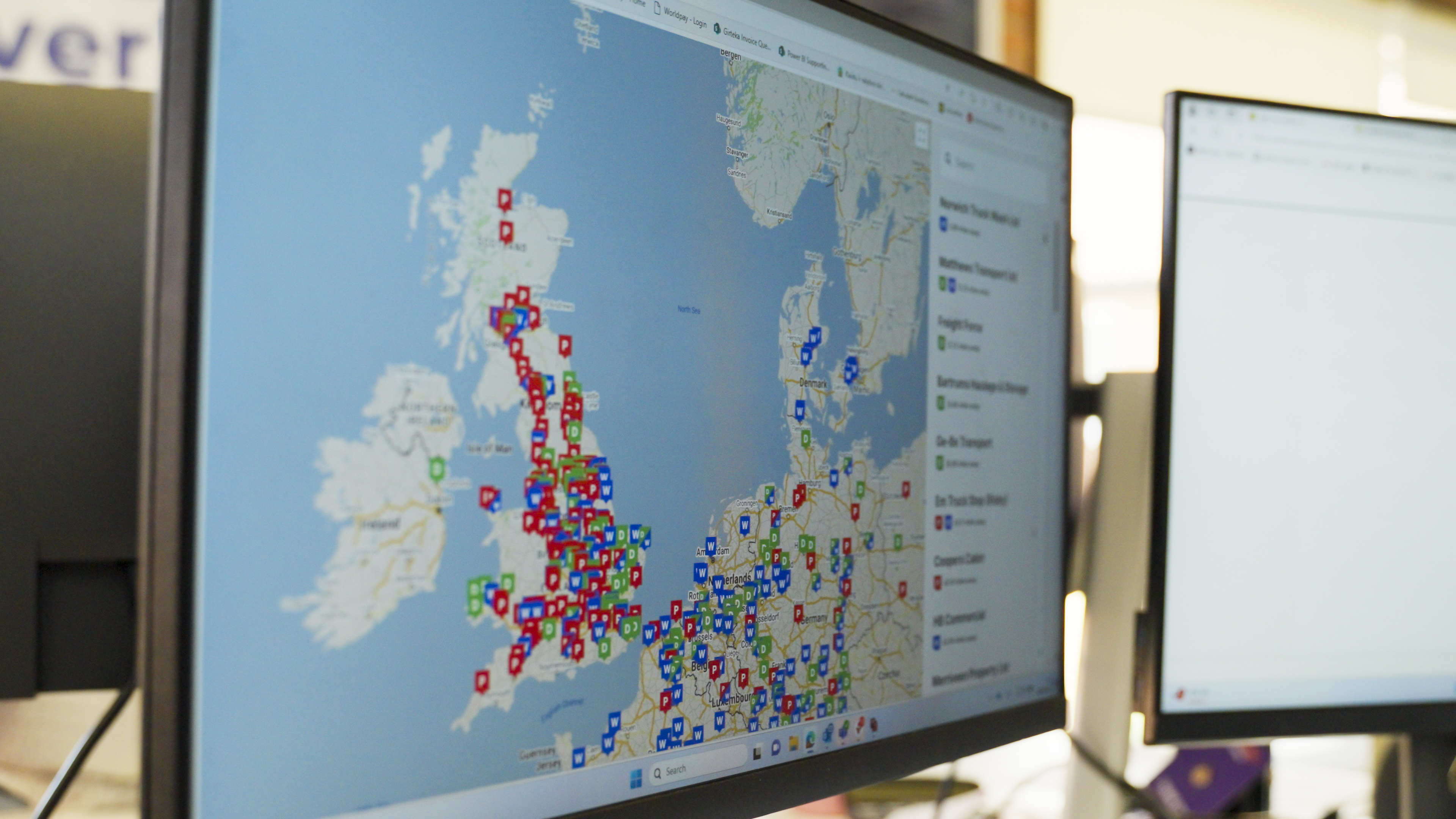
Miranda Blake
Brændstofkort i transportsektoren - hvordan SNAP forenkler flådens liv
Oprettet: 20.11.2024
•
Opdateret: 20.11.2024
Behovet for effektive [fleet management]-løsninger (https://snapacc.com/fleet-operators/) har aldrig været mere kritisk. SNAP Account er et stærkt alternativ til traditionelle brændstofkort og giver en omfattende, brugervenlig platform, der forenkler betalinger og forbedrer driftseffektiviteten. Ved at løse vigtige problemer som omkostningskontrol, administrativ byrde og chaufførtilfredshed baner vi vejen for en ny æra inden for flådestyring.
Omfattende betalingsløsning
SNAP Account er en alt-i-en-løsning til flådebetaling, som revolutionerer chaufførernes håndtering af forskellige udgifter. Ved blot at bruge køretøjets nummerplade kan de betale for en række tjenester, herunder:
- Parkering: Adgang til over 380 dedikerede lastbilparkeringer i hele Europa sikrer, at de altid har et sikkert og trygt sted at hvile.
- Vaskerier: Med mere end 230 faciliteter til rådighed er det problemfrit at holde køretøjerne rene.
- Brændstof:** Chauffører kan tanke på partnerstationer, hvilket strømliner driften. Dartford crossing charges: Automatiserede betalinger for vejafgifter eliminerer behovet for at håndtere kontanter.
Vi reducerer byrden ved at bære flere kort eller kontanter betydeligt, da vores software konsoliderer disse forskellige betalinger i et enkelt system.
Forenklet administration
For flådechefer kan de opgaver, der er forbundet med brændstofkort, være overvældende. Heldigvis gør SNAP Account disse processer enkle på flere måder:
- Én faktura:** Alle transaktioner samles på én faktura, hvilket drastisk reducerer papirarbejdet og de administrative omkostninger. Automatiseret bogføring: Denne funktion forenkler skatterapportering og økonomistyring og sparer værdifuld tid.
- Lastbiladministration:** Der er mulighed for at tilføje så mange køretøjer som nødvendigt og gruppere dem efter type eller destination.
En sådan automatisering og centralisering sikrer, at flådecheferne kan fokusere på strategiske beslutninger i stedet for at drukne i papirarbejde.
Forbedret omkostningskontrol
SNAP Account tilbyder effektive værktøjer til at optimere udgifterne:
- Udgiftsgrænser:** Flådechefer kan sætte begrænsninger og godkende indkøb, så udgifterne holdes inden for budgettet.
- Rabatter:** Eksklusive priser på vores partner-tankstation, Certas Energy, giver mulighed for betydelige besparelser.
- Ingen oprettelsesgebyrer:** I modsætning til traditionelle brændstofkortsystemer er der ingen oprettelses- eller abonnementsgebyrer, hvilket gør det nemmere at komme i gang.
- Ingen skjulte gebyrer:** Vi fjerner de tillæg, som brændstofkortselskaber typisk opkræver for truckstop-tjenester, hvilket sikrer gennemsigtighed i prissætningen.
Disse funktioner gør det muligt for virksomheder at styre deres brændstof- og serviceudgifter effektivt, hvilket fører til forbedret rentabilitet.
Er du interesseret i, hvordan andre drager fordel af SNAP? [Læs vores casestudie] (https://snapacc.com/newsroom/efficiency-on-the-road-how-delintra-sp-zoo-are-optimising-their-fleet-with-snap/).

Fordele for chaufføren
SNAP Account er designet med chaufføren i tankerne og tilbyder mange fordele, der forbedrer deres oplevelse på vejen:
Streamlinede betalinger: Glem alt om at jonglere med flere kort eller kontanter. Enkelheden ved kun at bruge køretøjets nummerplade til transaktioner er en game changer. * Omfattende netværk:* Med adgang til over 600 servicepartnere i hele Europa kan de nemt finde de tjenester, de har brug for. * Forudgående booking:* Appen [intruck] (https://intruckapp.com/) gør det nemt at booke parkeringspladser til lastbiler, så chaufførerne kan sikre sig deres pladser på forhånd.
Ved at forenkle livet på vejen forbedrer vi flådens effektivitet og øger chaufførernes tilfredshed, hvilket gør os til det foretrukne valg for mange operatører.
Sikkerhed og forebyggelse af svindel
I en branche, hvor sikkerhed er altafgørende, har SNAP Account flere robuste funktioner til at beskytte flådens aktiver:
- Registrerede nummerplader:** Hver transaktion er baseret på en registreret nummerplade, som sikrer, at kun autoriseret personale og køretøjer kan foretage betalinger. Udgiftskontrol: Ledere kan sætte grænser og dermed reducere risikoen for misbrug.
- Sikre parkeringsmuligheder:** Mange partnerlokationer tilbyder forbedrede sikkerhedsfunktioner, som giver chaufførerne ro i sindet.
Disse foranstaltninger arbejder sammen for at skabe et sikkert miljø for flådedrift og beskytte både køretøjer og økonomi.
Udviklingen af brændstofkort
Brændstofkort har været en hjørnesten i flådestyring i årevis, men traditionelle brændstofkort kommer ofte med skjulte gebyrer, begrænsede servicemuligheder og besværlige administrative processer. I modsætning hertil løser [SNAP Fuel] (https://snapacc.com/snap-fuel/) disse mangler ved at tilbyde en moderne, omfattende løsning, der imødekommer kravene til moderne flådestyring.
Vigtige forskelle mellem SNAP og almindelige brændstofkort

Kundeudtalelser
Vil du vide, hvad andre har fået ud af SNAP Account? Her er, hvad nogle flådeoperatører har at sige:
Fenwick Haulage: "SNAP har forandret vores drift. Ikke mere bøvl med kvitteringer; vores chauffører bruger bare deres registreringsbevis. Det er en game changer." * L Cunningham & Daughter Haulage: "Den fleksibilitet, SNAP giver, har været uvurderlig. Vores chauffører kan parkere uden at bekymre sig om forudbetalinger, og faktureringen er problemfri." * Wincanton: "Brugervenligheden er uden sidestykke. Vores chauffører kan booke parkering og betale uden brug af kontanter eller kort, hvilket gør deres arbejde meget enklere." * Jack Richards: "SNAP har forbedret vores effektivitet og reduceret omkostningerne betydeligt. Det er et vigtigt værktøj for vores flåde."
Hvis du gerne vil høste fordelene for din egen flåde, kan du kontakte os på +44 (0)1603 777242.



